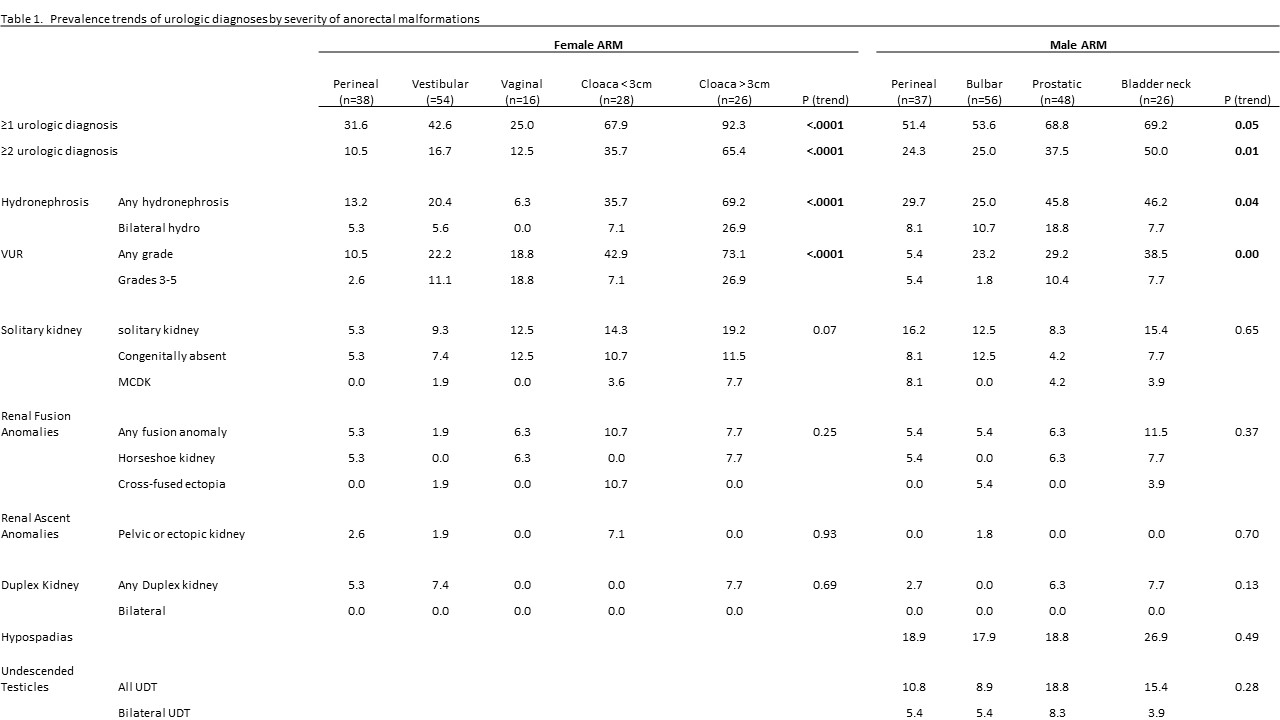CORRELATION OF ANORECTAL MALFORMATION SEVERITY AND ASSOCIATED UROLOGIC ABNORMALITIES: A REVIEW OF 329 PATIENTS
Molly Fuchs, MD, Yuri Sebastiao, PhD, MPH, Laura Weaver, MA, Nolan Farrell, BS, Devin Halleran, MD, Christina Ching, MD, Richard Wood, MD, Marc Levitt, MD, Daniel Dajusta, MD.
Nationwide Children's Hospital, Columbus, OH, USA.
Background: It is well know that many children with anorectal malformations have associated urologic abnormalities. However, few studies have been large enough to evaluate an accurate incidence or associations between severity of malformation and urologic diagnosis. The purpose of our study is to determine the incidence of urologic diagnoses in a large cohort of children with anorectal malformation (ARM) and evaluate for any correlation between severity of ARM and urologic diagnosis.
Methods: An IRB approved database of children with ARM was reviewed. The following urologic diagnoses were tabulated: hydronephrosis, vesicoureteral reflux (VUR), solitary kidney, renal ascent anomalies (ectopic or pelvic), renal fusion anomalies (horseshoe or cross fused kidney), duplex kidney, hypospadias and undescended testicle. ARM types were defined by distal rectal anatomy. We then performed a correlation analysis to determine if there was a correlation between severity of ARM and each urologic diagnosis
Results: Of the 329 patients, 50% were male and 50% were female. Half of the female ARM patients had at least one urologic diagnosis and 26% had two or more urologic diagnoses. In male ARM, 60% had at least one urologic diagnosis and 32% had two or more. In both sexes, there was a very clear correlation between severity of ARM and having at least 1 and at least 2 urologic diagnoses. There was also a clear trend in both sexes in the incidence of any grade of VUR and any grade of hydronephrosis. The incidences of all other diagnoses were relatively similar among all children with ARM showing no significant correlation with severity of ARM. These results are summarized in Table 1.
Conclusions: Urologic anomalies are highly prevalent in children with ARM and more severe ARM have a higher incidence of urologic diagnoses. This data stresses the importance of proper ARM screening and for having a pediatric urology specialist involved in the management of such children. 
Back to 2018 Program




